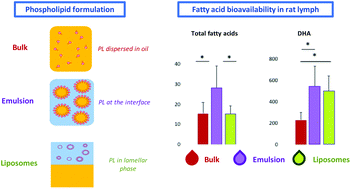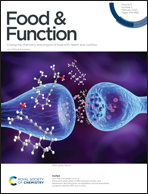Intestinal bioavailability of n-3 long-chain polyunsaturated fatty acids influenced by the supramolecular form of phospholipids†
Abstract
The aim of this work was to study the bioavailability of n-3 long-chain polyunsaturated fatty acids (n-3 LC-PUFA), i.e. eicosapentaenoic acid (EPA) and docosahexaenoic acid (DHA), carried by marine phospholipids (PL) and formulated in different supramolecular forms. Marine PL were administrated in rats either (1) in bulk form, or (2) as an oil-in-water emulsion, or (3) as liposomes. Each dietary formulation was characterized by a similar fatty acid (FA) profile and provided the same n-3 LC-PUFA amount. Intestinal bioavailability of n-3 LC-PUFA was monitored in the lymph compartment in a duct fistula model. On the one hand, the emulsification of plant oils with PL increased the overall intestinal absorption of dietary FA by 84% without affecting the lymph FA profile compared with the bulk form, suggesting that emulsification favoured the absorption of the total dietary FA derived from both triglycerides (TG) and PL. On the other hand, the liposome form did not modify the lymph lipid amount compared with the bulk form, but specifically increased the n-3 LC-PUFA levels. The dietary forms of PL influenced the position of some FA on the glycerol backbone of lymph TG and PL. In conclusion, using marine PL as an emulsifier promoted total FA absorption independently of the dietary lipid carrier (TG or PL) and the FA type. Structuring PL as liposomes specifically increased the intestinal bioavailability of FA esterifed in this lipid class, such as DHA, resulting in a higher incorporation into lymph lipids. Thus, using specific PL supramolecular forms would guide n-3 LC-PUFA towards total lipid absorption or specific FA absorption, according to the dietary needs.



 Please wait while we load your content...
Please wait while we load your content...